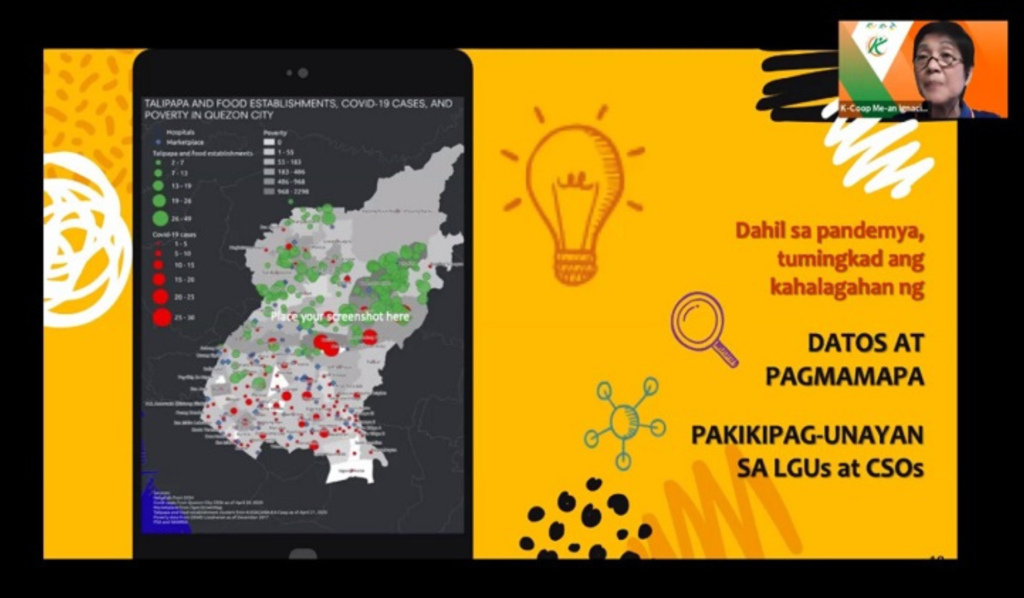
Mapping hazards, enhancing resilience
When COVID-19 pandemic hit the country, Bagong Silang in Caloocan City was heavily affected, with the highest number of positive cases in the city. Bagong Silang is the biggest barangay in the Philippines in terms of area size and population (246,515 as of 2015, according to the Philippine Statistics Authority)
“Sa patuloy na pagtaas ng aktibong kaso ng COVID-19, isa ang aming barangay sa lubhang tinamaan ng pandemya,” Camille Velasco, cluster manager of Kabuhayan sa Ganap na Kasarinlan Credit and Savings Cooperative (KCOOP) said. KCOOP is a cooperative that uses microfinance as strategy to uplift the lives of its members in urban and peri-urban communities from grassroots to climbing the economic ladder.
Velasco is one of the participants in the web-based Geospatial Risk Database (GRID) training held in February 2021. Organized by the National Resilience Council, Xavier University-Ateneo de Cagayan (Xavier Ateneo), and Manila Observatory, the GRID tool uses a geospatial or mapping technology that will assist Velasco and other participants in dealing with risks and vulnerabilities for a risk-informed decision making.
In their story map, Velasco showed that the high density of the population in the barangay heightened the risk of households contracting the virus, in addition to being a flood-prone area.
“Nakita po namin na magkakadikit ang mga kabahayan sa ating barangay. Isa po itong dahilan sa mabilis na pagkalat ng virus. Napakahirap ng sitwasyon kung may pag-ulan at pagbaha dahil sa bantang dulot ng pagkalat ng sakit,” she said.
During the exercise, KCOOP was able to plot the nearest hospitals, private clinics, medical centers for healthcare needs as well as public schools for evacuation sites during storms and heavy flooding.
“Talagang makakatulong ang mapping exercise sa pagdedesisyon at paggawa ng information campaign sa panahon ng sakuna. Sa ngayon ay patuloy po kaming nag-iisip ng pagpapaganda at pagsasaayos ng aming produkto at serbisyo upang mas makatulong sa pagalalay sa aming miyembro,” she said.
Let there be light through renewable energy
According to the National Electrification Agency, almost 2.3 million households in the country do not have access to electricity as of 2019.[1]
One of the regions where there are still thousands of households affected by this problem is South Cotabato, Cotabato, Sultan Kudarat, Sarangani and General Santos (SOCCSKSARGEN), particularly, Sultan Kudarat and Sarangani.
“In a focus group discussion conducted by our local partner Mahintana Foundation (MF), we found out that poverty and remote location contribute to lack of access to electricity,” Laurinette Gonzalez, senior information management officer of the Peace and Equity Foundation (PEF) said.
This prompted PEF, MF, the European Union, local electric cooperatives, and microfinance institutions to collaborate for strengthening off-grid lighting using appropriate renewable energy solutions. The project aims to benefit 6,000 off-grid rural households in the two provinces through the installation of solar home lighting systems while also providing access to livelihood and financing opportunities.
During the story mapping, PEF plotted the livelihood situations of the households in the off-grid communities and other hazards in the areas such as landslides and flooding.
“Aside from the lack of access to basic services and income opportunities, the communities experience landslides because of heavy rains. Their susceptibility to disasters is mostly moderate to high,” Gonzalez said.
The exercise has provided PEF some recommendations to strengthen the electrification project and its livelihood component.
“Looking at the hazards and target households, we recommend electric coops to consider training community members in maintenance and repair of their solar installation equipment. We can cluster farming communities for consolidation and marketing,” Gonzales said.
For its expected outcome, Gonzales shared that PEF is aiming to help households live comfortably without having to think about issues brought by hazards in the future.
[1] https://www.cnn.ph/news/2019/8/27/filipino-households-electricity-national-electrification-administration.html
Photo by: Xavier University (https://www.xu.edu.ph/xavier-news/170-xu-ateneo-news-sy-2020-2021/4924-xavier-ateneo-s-web-grid-resource-team-sustains-engagement-through-training-of-cooperatives-and-non-profit-organizations)